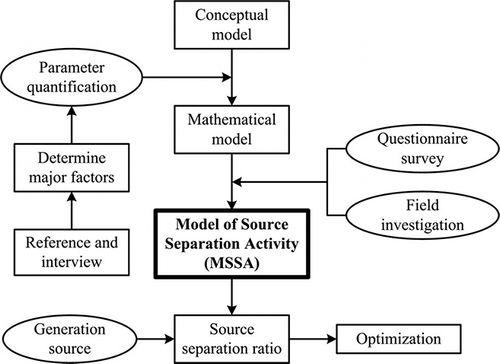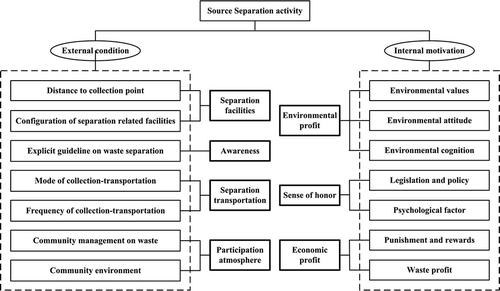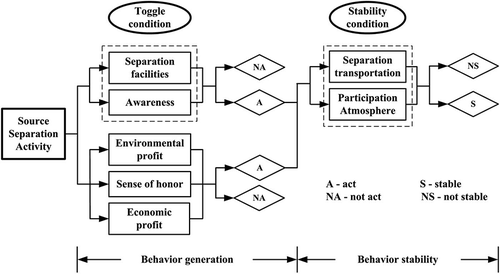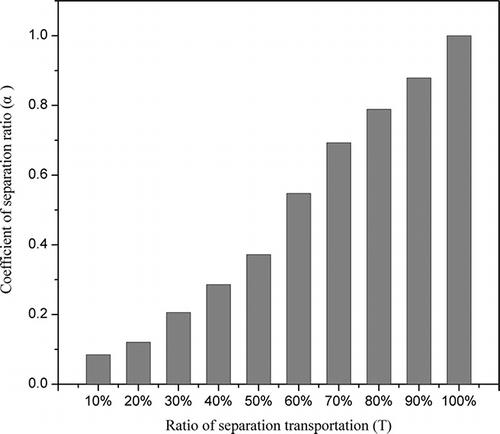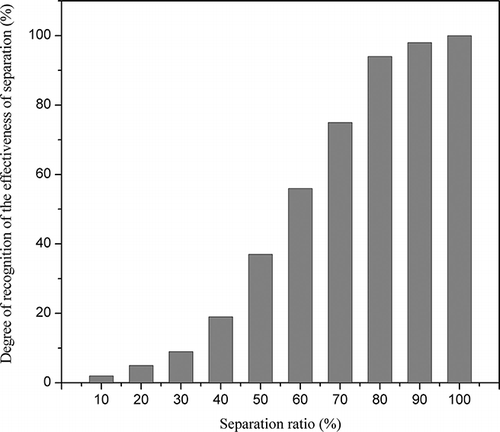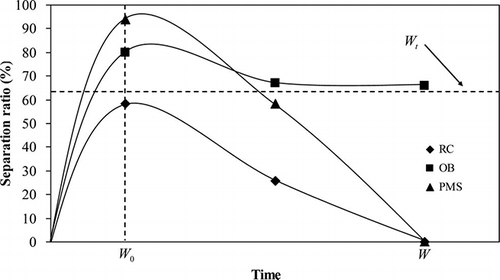ABSTRACT
One major challenge faced by Beijing is dealing with the enormous amount of municipal solid waste (MSW) generated, which contains a high percentage of food waste. Source separation is considered an effective means of reducing waste and enhancing recycling. However, few studies have focused on quantification of the mechanism of source separation activity. Therefore, this study was conducted to establish a mathematical model of source separation activity (MSSA) that correlates the source separation ratio with the following parameters: separation facilities, awareness, separation transportation, participation atmosphere, environmental profit, sense of honor, and economic profit. The MSSA consisted of two equations, one related to the behavior generation stage and one related to the behavior stability stage. The source separation ratios of the residential community, office building, and primary and middle school were calculated using the MSSA. Data for analysis were obtained from a 1-yr investigation and a questionnaire conducted at 128 MSW clusters around Beijing. The results revealed that office buildings had an initial separation ratio of 80% and a stable separation ratio of 65.86%, whereas residential communities and primary and middle schools did not have a stable separation ratio. The MSSA curve took on two shapes. In addition, internal motivations and the separation transportation ratio were found to be key parameters of the MSSA. This model can be utilized for other cities and countries.
This paper provides a method for calculation of the waste source separation ratio in different clusters using a mathematical model. Further detailed analysis of the waste separation status in other cities and countries can be conducted using this approach.
INTRODUCTION
Various waste reduction strategies have been attempted in most cities and countries in the field of municipal solid waste (MSW) integrated management. The key to the success of such strategies has generally been found to be MSW source separation, which is considered an effective means of enhancing waste recycling and disposal reduction.Citation1–3 Source separation refers to the separation of MSW into several categories at the generation source according to the different characteristics of each material before further treatment. The main body of source separation activity is the separation actor.
Few studies have been conducted to evaluate the mechanism of source separation activity or the separation actor itself, and even fewer quantification studies have been carried out. Four well-known environmental behavior theories are the theory of normative behavior,Citation4 the theory of reasoned action,Citation5 the theory of planned behavior,Citation6 and the attitudes-behaviors-conditions theory.Citation7 These theories were proposed to explain different relationships between environmental behavior and the factors influencing such behavior. They have also provided plentiful theoretical foundations for the environmental behavior intention of people from a social psychology and behavioristics viewpoint. However, they have not given a quantitative calculation or provided an explanation of the mechanism responsible for these behaviors.
Since 2000, the average annual increase in MSW generation has been approximately 6.7% in Beijing. In addition, the total MSW generation was 6.72 million t in 2008, with a per capita generation rate of 1.086 kg/day, and food waste comprised over 60% of this waste.Citation8 Beijing has 13 landfill sites and four incineration/composting plants, its total designed capacity was 10,350 t/day.Citation9 However, there is a large gap between the designed capacity and generation, and almost 90% of the MSW is treated by landfill.Citation10 Currently, MSW in Beijing is broadly separated into kitchen waste, recyclables, and other waste at the source; however, the enormous amount of waste generated and the high percentage of food waste are still important problems in MSW management in the city.
This study used Beijing as example to identify factors that were closely related to MSW source separation activity. The mathematical model of source separation activity (MSSA) was then set up. The MSSA is an original model designed to express the interactions among these influences. A questionnaire and field investigation data were also used to calculate the separation ratios at different MSW clusters ().
MSSA
The MSSA was designed to describe the source separation activity, which is a complex issue, simply and abstractly. Initially, two assumptions were proposed:
| 1. | Source separation activity was only influenced by external conditions and internal motivations. Physiological conditions and behavioral competence were not considered. The separation ratio was the only measurement of separation activity. | ||||
| 2. | The research target of the MSSA was group behavior instead of individual behavior. Thus, the gender, age, education, and other personal features of the actors were not included in the model. | ||||
Identification of Influencing Factors
Several factors directly or indirectly influence source separation activity. Wang and LuCitation11 considered whether providing an explicit guideline regarding waste separation to actors was an important condition for separation. Configuration of separation-related facilities,Citation7,Citation12–16 particularly waste bins, are other external conditions that influence behavior. The frequency and mode of collection-transportation are also perceived as external factors that influence behavior,Citation15–17 together with community management and the environment.Citation18 The actors' environmental values, attitudes, and cognition also all directly influence separation activity.Citation19 Legislation and policy, psychological factors, punishment, rewards, and profit are also good motivators that are approved by actors. These possible influences are listed in two columns in . These included distance to collection point, configuration of separation-related facilities, explicit guidelines for waste separation, model of collection-transportation, frequency of collection-transportation, community management of waste, community environment, environmental values, environmental attitude, environmental cognition, legislation and policy, psychological factors, punishment and rewards, and waste profit. These influencing factors have diversified impacts on source separation; thus, according to their mode of action, they were classified into four external conditions and three internal motivations: separation facilities, awareness, separation transportation, participation atmosphere, environmental profit, sense of honor, and economic profit.
Conceptual Model
A two-stage theory was presented to express interaction among these seven influences. To the best of the authors' knowledge, this is the first time a two-stage theory has been presented to express the interactions among such factors. As shown in , source separation activity was divided into two stages: behavior generation and behavior stability. In addition, all external conditions were divided into toggle conditions and stability conditions that adhered to two stages.
During the behavior generation stage, the toggle conditions of separation facilities and awareness and the three motivations of environmental profit, sense of honor, and economic profit had a significant effect on behavior. Conditions are considered to be necessary, whereas motivations are optional, which means that one motivation is sufficient to impel separation activity. During the behavior stability stage, only stability conditions of separation transportation and participation atmosphere determine whether action will be durative or not.
Mathematical Model
Two separation ratios were proposed to describe the source of separation activity. These were the incipient separation ratio (W 0) for behavior generation and the stable separation ratio (W) for behavior stability:
SURVEY AND DATA
The purpose of this survey was to obtain actual data regarding the model parameters and to identify basic information regarding MSW in Beijing. The survey consisted of a 1-yr field investigation and a questionnaire. The investigation was conducted at 128 MSW clusters located in 14 districts in Beijing and referred to three types of clusters: residential community (RC), office building (OB), primary and middle school (PMS) (). Each of these clusters had participated in waste separation for at least 1 yr. A field investigation was also conducted to obtain the parameters of F, K, and T. Questionnaires were handed out to 597 respondents, and there were 593 acceptable completed questionnaires returned, giving an overall response rate of 99.3%. Respondents, including residents, office workers, and students (), were all interviewed face to face. P(E n), P(E o), P(E c), α, and W t were determined from the questionnaire.
Table 1. Distribution of MSW clusters included in field investigation
Table 2. Detailed information of respondents
RESULTS AND DISCUSSION
Parameter Calculation
1. Ratio of Waste Separation Facility Configuration (F)
F was calculated as follows:
2. Ratio of Actors' Awareness (K)
The following three questions were designed to determine if the respondents were really aware of waste separation:
| 1. | Do you know that MSW is separated into kitchen waste, recyclable waste, and other waste in Beijing City? A. completely know, B. roughly know, C. absolutely not. | ||||
| 2. | Do you think kitchen waste is the only waste generated in the kitchen? A. yes, B. no. | ||||
| 3. | Do you think plastic bags and milk cartons are unrecoverable waste? A. yes, B. no | ||||
K was calculated as follows:
Table 3. Parameter calculation and optimization results of the MSSA
3. Maximum Probability of Motivation (Pmax)
The maximum probability of motivation was determined by a multiple-choice question as follows:
| • | Question: What are the leading factors that motivate you to participate in waste separation in your residential community/workplace/school? (multiple choice) | ||||
| • | Answers: A. environmental profit, B. sense of honor, C. economic profit | ||||
Respondents could choose one, two, or all three options as their leading motivation. lists part of the questionnaire results for the RC. The calculation steps were as follows: (1) determine the sum of each column, (2) the sum of each column was divided by the total number of respondents to determine the ratio of each motivating factor, and (3) the maximum probability of motivation was selected as P max for later model calculation. The results showed that P(E n)(0.692) > P(E c)(0.359) > P(H o)(0.247) in RC, P(E n)(0.889) > P(H o)(0.318) > P(E c)(0.101) in OB, and P(E n)(0.990) > P(H o)(0.264) > P(E c)(0.132) in PMS. Thus, P max was simply P(E n) in each type of cluster ().
Table 4. Part of questionnaire results of residents
4. Ratio of Separation Transportation (T)
T was determined from the mass of waste transport-separated divided by the total mass of MSW:
5. Coefficient of Separation Ratio (α)
Transportation is not influenced by source separation by actors, but the incipient separation ratio is a direct result of separation by the actors. As a result, there is no direct relationship between T and the incipient separation ratio. Thus, it was necessary to introduce α, an important coefficient, as a bridge. This value was obtained from the following hypothetical question:
| • | Question: You will keep separating waste when the separation transportation ratio is ? | ||||
| • | A. 0–10%, B. 10–20%, C. 20–30%, D. 30–40%, E. 40–50%, F. 50–60%, G. 60–70%, H. 70–80%, I. 80–90%, J. 90–100% | ||||
The respondents had no awareness of what the ratio of food to other wastes was or what the community ratio was. Therefore, they were told what the ratio of separation transportation (T) was during the face-to-face interview and the definition was also provided after the question. The respondents only needed to identify the T value that induced them to participate in source separation. The results revealed that T and α presented an approximate linear correlation (); therefore, it was possible to use linear interpolation to determine the α value for any T.
6. Recognition of Separation Effectiveness (Wt)
W t was introduced for two reasons. On one side, actors may have different opinions regarding the degree of MSW separation. For example, some actors may consider separation to be thoroughly achieved when part of the bottles or papers are separated, but others may not think so. This distinction is defined as the degree of recognition of separation effectiveness. Conversely, people always would like to take separation action following the other ones. This can be explained as group psychology and also appears as group behavior regarding separation activity.
A hypothetical question was designed for W t as follows:
| • | Question: You will recognize separation effectiveness when the separation ratio is ? | ||||
| • | A. 0–10%, B. 10–20%, C. 20–30%, D. 30–40%, E. 40–50%, F. 50–60%, G. 60–70%, H. 70–80%, I. 80–90%, J. 90–100% | ||||
The separation ratio in this question was not calculated from the model but was defined as the mass of all separated waste (not the mass of separated food waste alone) divided by the total generation. This definition was also provided in the questionnaire. The respondents only needed to determine which separation ratio could represent achievement of source separation in their opinions. As shown in , 37% of the respondents recognized separation effectiveness when the separation ratio was 50%, and this value rose to 94% when the separation ratio was 80%. The threshold value of the model was equal to the separation ratio
When the separation ratio was smaller than 64.4%, W t was always smaller than the corresponding separation ratio. These results indicate that only a few actors consider the separation to be effective, so the separation activity will not last for a long time. However, the opposite was true when the separation ratio was larger than 64.4%. In this case, increasing numbers of actors consider the separation to be effective as the separation ratio increases, indicating the potential for sustainable separation activity.
Model Results
Incipient separation ratios of RC, OB, and PMS were 58.5, 80, and 93.8% (), which were all higher than the average level for all of Beijing (53%). When TW 0 and W t were compared, the separation activity was stable in OB but not in RC or PMS. Therefore, the stable separation ratio of OB was 65.86%, but tended to be zero in RC and PMS.
showed the separation ratio curve for three types of clusters. The MSSA curve took on two shapes, a pattern of 150 and a pattern of ┌. The former was represented by clusters of RC and PMS, and the latter was represented by a cluster of OB. W 0 is the demarcation point of the MSSA curve. Before that point, the separation ratio increased quickly to a maximum. This phenomenon was shared in both patterns and this process was identical to the behavior generation stage. However, after the demarcation point, the separation ratio declined to zero in pattern ∧ and dropped slightly in pattern ┌.
Optimization and Recommendation
F, K, T, P max, and α are the major parameters of the MSSA. According to the assumption and mathematical model, F, K, P max, and T had a positive influence on W 0, and α was positively related to T. Thus, a larger parameter is associated with a more positive outcome.
As shown in , F and K were above 90% and had few distinctions among sources, whereas P max varied markedly. These results indicate that P max was a key parameter of the MSSA. As mentioned above, P max was obtained from P(E c), P(E n), and P(H o) directly. Office workers and students considered E n the most important motivation, with almost 90% reporting that they would like to take part in separation activity for environmental profit. However, this value was only 70% for residents. In addition, nearly 36% of residents chose E c as a secondary motivation, and this percentage was 3 times greater than that of office workers and students. Additionally, P(E c) was even smaller than P(H o) in OB and PMS. Therefore, P max may not reflect the influence of all motivations, especially in cases in which more than one dominant motivation was presented. Using joint probability to replace P max may solve this problem.
After such an adjustment, P max would increase to 0.945 and 0.990 for residents and office workers, but there would be no changes for students. Additionally, W 0 would increase to 79.90, 89.10, and 93.80% in RC, OB, and PMS, respectively. Therefore, E c was an effective motivation to promote the separation activity of residents when E n did not work well. H o also promoted separation activity by office workers when E n did not work well, but this effect was not obvious for students.
T was another key parameter of the MSSA because it not only influenced α, but also the separation stability. The gap between W 0 and W in PMS demonstrated the importance of T. PMS had the highest W 0, but W was zero. This was largely because of a lower T (62.36%). Although T was 83.75% in OB, it was only 1.5% higher than W t when multiplied by W 0. If T was upgraded to 90%, then α would be 0.879 and W would increase to 70.20% (RC), 78.30% (OB), and 82.50% (PMS).
In general, there are two methods used to increase the separation ratio according to the key parameters. First, secondary internal motivation is used to strengthen the effectiveness of the primary goal. For example, economic means such as cash rewards or subsidy should be attractive to residents, and public commendation may be widely accepted by students. Second, separation transportation should be strengthened. It is suggested that additional workers, improved vehicles, and increased collection frequency be implemented to accomplish this.
CONCLUSIONS
| 1. | The MSSA is a good method of quantifying the mechanism by which source separation activity is influenced. The MSSA is divided into two parts, the former being used to describe behavior generation that is influenced by toggle conditions and internal motivations and the latter being used to determine if the behavior is stable and influenced by stability conditions. The incipient separation ratio and stable separation ratio can be calculated using this model. | ||||
| 2. | All parameters in the MSSA can be obtained by survey. Most parameters vary among clusters, whereas the criterion of the model is invariable at 64.4%. The coefficient of the separation ratio (α) and recognition of the effectiveness of separation (W t) take on regularity in the transportation ratio and separation ratio, respectively. | ||||
| 3. | The MSSA curve had two patterns, ∧ and ┌. The curve ascended quickly at first, but after arriving at the maximum separation ratio, it gradually descended to zero in pattern ∧ and descended slightly in pattern ┌. | ||||
| 4. | Internal motivations and the separation transportation ratio are the key parameters of the MSSA. Environmental profit is the primary motivation, followed by economic profit for residents, but sense of honor is a secondary motivation after environmental profit for office workers and students. Thus, it is necessary to propose different policies to enhance separation activity by different actors. | ||||
| 5. | The MSSA can be applied to any type of MSW cluster, such as commercial places and hotels. It can also be utilized for other cities. | ||||
ACKNOWLEDGMENTS
This study was supported by the National Basic Research Program of China (grant no. 2009CB421308). The authors are grateful to the Beijing Solid Waste Administration Department for their help.
REFERENCES
- Yuan , H. , Wang , L.A. , Su , F.W. and Hu , G. 2006 . Urban Solid Waste Management in Chongqing: Challenges and Opportunities . Waste Manage. , 26 : 1052 – 1062 .
- Hu , D. , Wang , R.S. , Yan , J.S. , Xu , C. and Wang , Y. 1998 . A Pilot Ecological Engineering Project for Municipal Solid Waste Reduction, Disinfection, Regeneration and Industrialization in Guanghan City, China . Ecol. Eng. , 11 : 129 – 138 . in Chinese
- Chung , S.S. and Poon , C.S. 2001 . A Comparison of Waste Reduction Practices and New Environmental Paradigm of Rural and Urban Chinese Citizens . J Environ. Manage. , 62 : 3 – 19 .
- Schwartz , S.H. 1977 . Advances in Experimental Social Psychology , Edited by: Berkowitz , L. New York : Academic .
- Fishbein , M. and Ajzen , I. 1975 . Belief, Attitude, Intention, and Behavior: An Introduction to Theory and Research , Reading , MA : Addison-Wesley .
- Ajzen , I. 1985 . From Intention to Actions: A Theory of Planned Behavior , Heidelberg , , Germany : Springer .
- Guagnano , G.A. , Stern , P.C. and Dietz , T. 1975 . Influences on Attitude-Behavior Relationships: A Natural Experiment with Curbside Recycling . Environ. Behav. , 27 : 699 – 718 .
- 2009 . Beijing Statistical Yearbook , Beijing , , Republic of China : Beijing Municipal Bureau of Statistics . in Chinese
- Li , Z.S. , Yang , L. , Qu , X.Y. and Sui , Y.M. 2009 . Municipal Solid Waste Management in Beijing City . Waste Manage. , 29 : 2596 – 2599 .
- 2007 . Beijing Environmental Sanitation Development Report , Beijing , , Republic of China : Beijing Municipal Administration Commission . in Chinese
- Wang , Y. and Lu , Y.S. 2001 . Factors Promoting Municipal Solid Waste Sorting Collection . Environ. San. Eng. , 9 : 190 – 192 . in Chinese
- Nyles , V.R. 1992 . Community Recycling: System Design to Management , New York : Prentice Hall .
- Derksen , L. and Gartell , J. 1993 . The Social Context of Recycling . Am. Sociol. Rev. , 58 : 434 – 442 .
- Barr , S. 1998 . Ph.D. Dissertation , United Kingdom : University of Exeter .
- McDonald , S. and Ball , R. 1998 . Public Participation in Plastics Recycling Schemes . Resour. Conserv. Recy. , 22 : 123 – 141 .
- Perrin , D. and Barton , J. 2001 . Issues Associated with Transforming Household Attitudes and Opinions into Materials Recovery: A Review of Two Kerbside Recycling Schemes . Resour. Conserv. Recy. , 33 : 61 – 74 .
- Jiang , Y. , Kang , M.Y. , Zhang , X.G. and Zhou , Y.F. 2007 . Cognition of Resources Recovery and Quantitative Reduction towards Urban Domestic Garbage among Residents in China . Resour. Sci. , 24 : 15 – 19 . in Chinese
- Bennagen M.E.C.; Neponuceno G.; Covar R. Solid Waste Segregation and Recycling in Metro Manila: Household Attitudes and Behavior; 2002 http://www.idrc.ca/uploads/user-S/10510800420EugeneRR.edited.doc (http://www.idrc.ca/uploads/user-S/10510800420EugeneRR.edited.doc) (Accessed: 2010 ).
- Kuo, T.P. A Study of Behavior Intention for Resource Recycling of Residents at Different Type of Communities; 2004 http://203.72.2.115/EJoural/3042050102.pdf (http://203.72.2.115/EJoural/3042050102.pdf) (Accessed: 2010 ).
